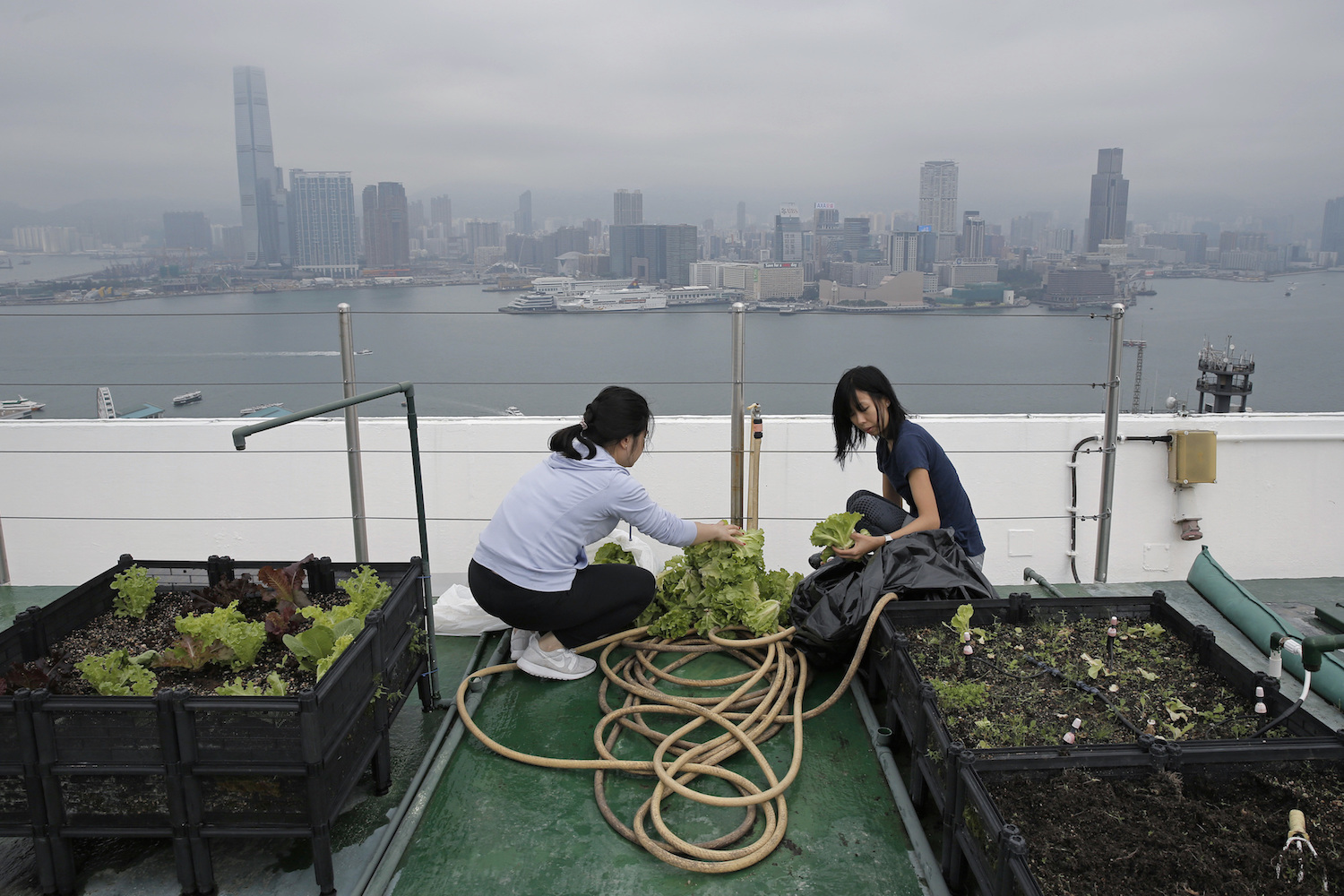香港繁華街の、多くの人がひしめき合う賑やかな通りの上空で、会社員たちがせっせと働いていた。企業買収や公募増資を検討しているのではない。香港にそびえ立つ超高層ビルの屋上で、大豊作となったレタスの収穫に精を出しているのだ。
そこは究極の屋上菜園を目指し、食物を生産することよりも幸福感を得ることを目的とした屋上菜園だ。

AP Photo / Kin Cheung
38階建てのバンク・オブ・アメリカ・タワーの、地上146メートル(480フィート)にある屋上には現在使用されていないヘリポートがあり、そこでボランティアの人たちが、何列にも並んだ黒いプラスチック製のプランターから、サラダ菜、インディアンレタス、カラシナを摘み取っていた。屋上からは、青々とした山々と、ビクトリア・ハーバーに囲まれ、ガラス張りの高層オフィスビルが立ち並ぶ目の回るような風景を見渡すことができる。
バンク・オブ・アメリカ・タワーを管理する不動産会社の社員で、ボランティアに参加しているキャサリン・ウンは、「泥だらけになるが、心から楽しんでいる」と言う。
その家庭菜園は、ルーフトップ・リパブリックが運営している。ルーフトップ・リパブリックは創業3年のスタートアップ企業だ。創設陣はオーガニック食品への関心を高めており、建物が密集し、家賃が高い香港で、屋上の使っていないスペースを有効活用している。
オフィスビルと高層マンションが密集し、多忙な富裕層でごった返した香港は、家庭菜園が流行するような場所とは思えないだろう。金融と貿易のハブとなっている香港には、郊外には田舎があるものの、農地は700ヘクタール(1,730エーカー)しかなく、農業が経済産出量に占める割合は0.1%程度だ。ルーフトップ・リパブリックの創設陣によると、持続可能性のより高いライフスタイルを求め、食品の生産元を気にかけている香港の住民の間で、同社のサービスへの需要が高まっている。

AP Photo / Kin Cheung
創設者のひとりであるミシェル・ホンは、「私たちは、自らの手で食物を育てたいという人からの注目が大きくなってきた」と言う。「食品の安全性への懸念が生じたこと、自分の消費する食品に大量の農薬が使用されていることが認知されるようになったことがきっかけとなり、注目が増した。人々は、より徹底した管理と共に、より確かな信頼を求めていると思う」。
香港は食品のほぼすべてを輸入に頼っており、その大半を中国本土から調達している。旧イギリス植民地である香港では、中国本土で数えきれないほどの食品汚染が発覚した後、食品の安全に対する市民の意識が高まった。
ミシェルによると、ルーフトップ・リパブリックは創設以降、平均して1ヵ月に1ヶ所のペースで屋上菜園を設置し、現在は中国本土の1ヶ所を含む36カ所、30,000平方フィート(約2,800平方メートル)超に及ぶ屋上菜園を管理している。同社はまた、企業、ビルのオーナー、学校、地域団体に向けたワークショップも開催している。
- AP Photo / Kin Cheung
- AP Photo / Kin Cheung
- AP Photo / Kin Cheung
香港の金融街では初の屋上菜園となったことから、アメリカン・バンク・タワーの屋上菜園はひとつの画期的な出来事となった。ミシェルによるとルーフトップ・リパブリックは、金融街の2ヶ所に菜園を増設し、さらなる増設に向け場所を探している。タワーで収穫した食物はフード・バンクに寄付され、貧困者に配布する弁当に使用される。ホテルやレストランにもいくつか菜園を導入しており、メニューにある料理に、ハーブ、ナス、メロンが使用されている。
香港大学で建築学を専門としているマシュー・プライヤー教授によると、他にも数々の団体、個人が各自で屋上菜園の開拓を始めている。マシュー教授が数えただけでも60カ所の屋上菜園が存在し、確認できていないものも含めるとさらに多くの菜園があると考えられる。
マシュー教授が調査した結果、約1,500人が屋上菜園に参加し、合計約1.5ヘクタールの敷地を開拓していることがわかった。同氏の考えでは、菜園に適した屋上は600ヘクタールにのぼり、参加者はすぐにも50,000人に達する可能性がある。マニュー教授は、ある大学の屋上における菜園の設置に協力した。その屋上菜園では、大学職員を中心とするボランティアが、トマト、ジャガイモ、レタス、ドラゴンフルーツ、パパイヤ、豆類、エンドウ、カボチャを育てている。
マシュー教授は調査を進める中で、屋上菜園の主な生産物は、食物ではないことに気付いたと述べている。香港全体の消費量に比べると、「屋上菜園の生産量はないようなものだ」と言う。「しかし屋上菜園が本当に生産しているものは幸福感であり、屋上菜園が生み出す社会資本は莫大だ」
ストレス過多でオーバーワークの、社会的に孤立した香港の住民は、屋上菜園に参加することで友人と繋がりを持ち、自然と対話できるため、幸せを感じることができ、幸福度の向上に繋がる。
ランタオ島の田舎地域、香港国際空港付近にあるキャセイパシフィック航空本社で、ルーフトップ・リパブリックが運営する屋上菜園では、このような恩恵がもたらされていた。航空会社の社員は、ケール、キャベツ、ラディッシュ、ニンジンなど、冬に育成期を迎え、寒く乾燥した香港の冬にも立派に育ちそうな作物を選んで植えた。
ボランティアのプリアン・チャンは、「海のすぐ近くなので、港の素晴らしい景色が広がっているが、同時に空港の景色も楽しむことができる。2分おきに飛行機を眺めている」と話す。「ここは最高の場所だ」。
—
By KELVIN CHAN, AP Business Writer
HONG KONG (AP)
High above downtown Hong Kong’s bustling, traffic-clogged streets, a group of office workers was toiling away not on a corporate acquisition or a public share offering but on harvesting a bumper crop of lettuce atop one of the skyscrapers studding the city’s skyline.
It’s rooftop farming taken to the extreme, and more about reaping happiness than providing food.
The volunteers were picking butter lettuce, Indian lettuce and Chinese mustard leaf in rows of low black plastic planters on a decommissioned helipad on the 146-meter (480-foot)-high roof of the 38-story Bank of America tower, the scenery: a vertiginous panorama of glass office towers framed by lush mountain peaks and Victoria Harbor.
“It’s pretty dirty but still I really enjoy it,” said Catherine Ng, one of five volunteers who work for the property company managing the tower.
The farm is run by Rooftop Republic, a three-year-old startup whose founders are tapping growing interest in organic food and taking advantage of unused roof space in the cramped, high-rent Chinese city.
Hong Kong, with its skinny office blocks and apartment towers and busy, affluent residents, might seem an unlikely place for rooftop farming to catch on. The finance and trading hub has rural suburbs, but farming only takes up 700 hectares (1,730 acres) of its land and agriculture accounts for 0.1 percent of its economic output. Rooftop Republic’s founders say the appetite for their services is growing among Hong Kongers who are seeking a more sustainable lifestyle and concerned about where their food comes from.
“We have been getting more and more interest from people who want to grow their own food,” said Michelle Hong, one of the founders. “A lot of it is triggered by concerns about food safety and the realization that a lot of the food they consume might be laden with pesticides. I think people want to have more control and also more trust.”
Hong Kong imports almost all of its food, much of it from mainland China. Public awareness about food safety in the former British colony has risen after countless food contamination scandals on the mainland.
Rooftop Republic has set up on average one farm a month since its founding and now manages 36 covering more than 30,000 square feet (about 2,800 square meters), including one in mainland China, Hong said. It also provides workshops for companies, building owners, schools, and community groups.
The Bank of America farm was a milestone because it was the first in the city’s financial district. The company has since set up two more in the area and is looking at a few more sites, Hong said. Vegetables from the tower are donated to a food bank for uses in lunch boxes distributed to the needy. Some of its other farms are at hotels or restaurants, which use the herbs, eggplants and melons for dishes on their menus.
Plenty of other groups or individuals have started cultivating their own rooftop vegetable gardens, said Matthew Pryor, a Hong Kong University architecture professor who has counted at least 60 and thinks there are a lot more he doesn’t know about.
Pryor’s research found approximately 1,500 rooftop farmers in the city, cultivating a total area of about 1 ½ hectares. He thinks there’s potential for that to easily grow to 50,000 people working on a suitable rooftop area of 600 hectares.
He helped set up a farm on top of a university building where volunteers, mainly staff, grow tomatoes, potatoes, strawberries, lettuce, dragonfruit, papaya, beans, peas and squash.
Pryor said he discovered through his research that their main product isn’t edible.
“The rooftop farms here produce virtually nothing” compared to Hong Kong’s overall consumption, Pryor said. “What they do produce, however, is happiness, and this social capital that they generate is enormous.”
The farms can help stressed-out, overworked and socially isolated Hong Kongers be happier and improve their well-being by letting them hang out with their friends and commune with nature.
Those benefits were on display at another Rooftop Republic farm at airline Cathay Pacific’s headquarters near the city’s airport on rural Lantau Island.
Airline staff planted crops that thrive in Hong Kong’s cool, dry winter growing season, like kale, cabbage, radishes and carrots, which they can take home.
“We’re right by the sea, we have great views of the harbor, at the same time have got great views of the airport. We see planes every two minutes,” said volunteer Prian Chan. “So it’s awesome to be here.”
—
By KELVIN CHAN, AP Business Writer
HONG KONG (AP)






